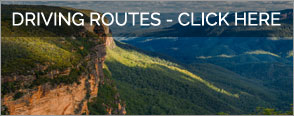The Greater Blue Mountains World Heritage Area:
- was accepted onto the World Heritage List on 29 November 2000
- was listed for its superlative representation of Australia's unique and characteristic eucalypt vegetation
- is one of 17 World Heritage sites in Australia, and 851 in the world (in 2007)
- covers more than 10,000 square kilometres
- stretches for 220 km from north to south
- lies only 60 km from the centre of Sydney
- is made up of eight adjoining conservation reserves - Jenolan Karst Conservation Reserve and Yengo, Wollemi, Gardens of Stone, Blue Mountains, Kanangra-Boyd, Nattai and Thirlmere Lakes National Parks
- protects 70 different vegetation communities, more than 1,500 species of higher plants (representing 10% of Australia's total) and at least 100 species of eucalypt (13% of the world's total)
- protects at least 150 plant species that are found only in the Greater Blue Mountains
- saves one of the largest areas of protected forest in Australia
- has been inhabited by Aboriginal people for at least 12,000 years
- overlaps the traditional Country of at least six indigenous language groups - the Wanaruah, Darkinjung, Darug, Wiradjuri, Gundungurra and Dharawal
- protects 700 known places of Aboriginal significance, and many others yet to be recorded
- includes one area (Jenolan Karst Conservation Reserve) that has been continuously protected since 1866
- ranges in elevation from near sea level on the Hawkesbury-Nepean River to 1,334 metres on the Boyd Plateau
- is in such good natural condition that 51% of it has been classified as Wilderness for extra protection
- includes the largest wilderness (Wollemi Wilderness) in eastern Australia between Cape York Peninsula and Tasmania
- provides vital clean water to Sydney's main water supply catchment of Lake Burragorang, as well as many smaller catchments





